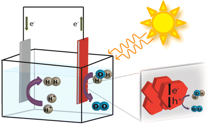iNANO and Shanghai researchers improve photoelectrocatalysis of water oxidation

A large part of total world energy consumption is derived from non-renewable fossil fuels. Replacing this source of energy by solar energy via harvesting it in photovoltaic devices is a challenging and highly attractive alternative, particularly through the photoelectrocatalytic water splitting reaction schemes.
Within the China-Denmark collaborative program: the Sino-Danish Center for Education and Research (SDC), the iNANO (Biosensors and Bioelectrocatalysis group of Assoc. Prof. Elena Ferapontova) and the Shanghai Institute of Applied Physics (the group of Prof. Chunhai Fan) have developed metal-doped hematite photoanodes with improved photoelectrocatalytic activity and efficiency in the water splitting reaction, therewith demonstrating one of the best hitherto reported characteristics of photoelectrocatalysis.
The research article entitled “Visible Light Driven Photoelectrochemical Water Oxidation by Zn- and Ti- doped Hematite Nanostructure” is just published in ACS Catalysis (http://pubs.acs.org/doi/abs/10.1021/cs500372v).
